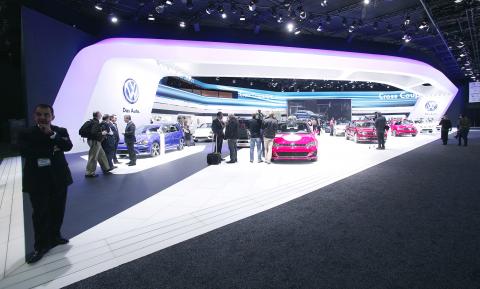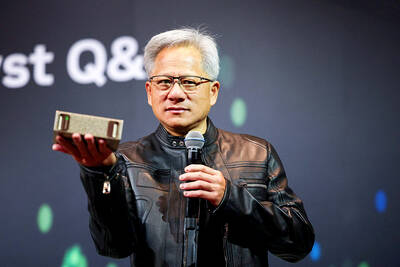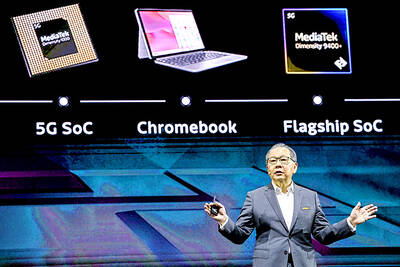The next time you buy a car, you might want to pause a while longer to decide what color you choose.
Top automakers throw millions of dollars at researching what the latest tastes are, and say the color of a vehicle is so important to customers that it can be the difference between buying or not.
The ongoing auto show in Detroit saw many of the classic colors — reds for Porsches and other sports cars — and a few less conventional (a Nissan Titan pickup truck decked out in “forged copper”).

Photo: AFP
However, there was no mistaking the preeminence of white, particularly at the Volkswagen stand, where several cars, the stairs and much of the furniture was white.
In a multibillion-dollar industry, nothing is put to chance and nothing is done by mistake, of course.
At least two designers in Detroit referred to the “Apple effect” — the Californian tech giant — to explain the propensity for white vehicles.
Sitting at a white table, on white chairs, in a white room, Volkswagen’s Oona Scheepers told reporters: “White for cars really peaked in the 1970s and 1980s, and then all of a sudden disappeared, “but in the last 10 years we have noticed an increase again in white. And it definitely came with the Apple iPod era because Apple started to do everything with white, and a lot of nice chrome or metal finishes.”
“In combination it was really nice and fresh, but before that, white was really not selling in Europe because people associated it with delivery cars and it looked cheap,” she said.
“But the combination with metal and chrome looks fresh and completely new. White is booming worldwide,” she added.
However, Scheepers, head of design, color and trim, said black was still Volkswagen’s best-seller — but only just.
So, if one were to choose a black vehicle over a white one, what kind of person would that make them?
“You could be sporty, but people in hot countries like white,” Scheepers said.
“White definitely deflects heat, but if you have a black car it can get damn hot inside, and then in a country like South Africa you often have to overtake into direct, oncoming traffic, but white is very visible,” Scheepers said.
“So it’s a safety feature as well in some countries. Metallic gray or black just melts into the color of the tar, so it is not that visible,” she added.
Susan Lampinen, chief designer, colors and materials, at Ford, said color was so crucial to some people that they would buy a car purely because of that — never mind the design of the vehicle.
She too identified an Apple ripple effect in propelling white to a best-seller worldwide for Ford.
“White is very clean, very technical, very modern. So most cars look good in white,” she told reporters in Detroit, adding other popular colors included blacks and silvers, while blue is also on the up.
Lampinen identified only “slight differences” in preferences in different countries because, she said, of globalization.
Climate, culture and environment can all affect what color car someone might buy, she added.
However, Scheepers saw stark contrasts between some countries, particularly when it comes to the US and China.
“China is going for very, very bold colors. America is still quite subdued. White sells extremely well here and there is still a preference for champagne-toned body colors and a movement towards the reds in America as well, but China is going for gold, extreme greens — it’s a mixture of a green and a brown — very expressive,” she said.
“There is a new awareness in China, they are becoming very self-confident, and they are expressing themselves,” she added.
That also applied to vehicle interiors, Scheepers said, with Chinese consumers going for much bolder designs.
Volkswagen research turned up a surprising anomaly, Scheepers said. It found that younger buyers want more sober-colored vehicles — while older consumers go for brighter ones.

SEEKING CLARITY: Washington should not adopt measures that create uncertainties for ‘existing semiconductor investments,’ TSMC said referring to its US$165 billion in the US Taiwan Semiconductor Manufacturing Co (TSMC, 台積電) told the US that any future tariffs on Taiwanese semiconductors could reduce demand for chips and derail its pledge to increase its investment in Arizona. “New import restrictions could jeopardize current US leadership in the competitive technology industry and create uncertainties for many committed semiconductor capital projects in the US, including TSMC Arizona’s significant investment plan in Phoenix,” the chipmaker wrote in a letter to the US Department of Commerce. TSMC issued the warning in response to a solicitation for comments by the department on a possible tariff on semiconductor imports by US President Donald Trump’s

‘FAILED EXPORT CONTROLS’: Jensen Huang said that Washington should maximize the speed of AI diffusion, because not doing so would give competitors an advantage Nvidia Corp cofounder and chief executive officer Jensen Huang (黃仁勳) yesterday criticized the US government’s restrictions on exports of artificial intelligence (AI) chips to China, saying that the policy was a failure and would only spur China to accelerate AI development. The export controls gave China the spirit, motivation and government support to accelerate AI development, Huang told reporters at the Computex trade show in Taipei. The competition in China is already intense, given its strong software capabilities, extensive technology ecosystems and work efficiency, he said. “All in all, the export controls were a failure. The facts would suggest it,” he said. “The US

The government has launched a three-pronged strategy to attract local and international talent, aiming to position Taiwan as a new global hub following Nvidia Corp’s announcement that it has chosen Taipei as the site of its Taiwan headquarters. Nvidia cofounder and CEO Jensen Huang (黃仁勳) on Monday last week announced during his keynote speech at the Computex trade show in Taipei that the Nvidia Constellation, the company’s planned Taiwan headquarters, would be located in the Beitou-Shilin Technology Park (北投士林科技園區) in Taipei. Huang’s decision to establish a base in Taiwan is “primarily due to Taiwan’s talent pool and its strength in the semiconductor

NEW PRODUCTS: MediaTek has been diversifying its product lines to minimize operational risks as mobile chips remain the company’s biggest revenue source MediaTek Inc (聯發科), the world’s biggest supplier of smartphone chips, yesterday said the tape-out process for its first 2-nanometer chip would take place in September, paving the way for volume production of its most advanced chip, likely to be its next-generation flagship smartphone chip, around the year-end at the earliest. MediaTek has been leveraging advanced process technologies from its foundry partner, Taiwan Semiconductor Manufacturing Co (TSMC, 台積電), to build its flagship mobile phone chips, a segment it once relinquished and then recovered four years ago as it released its Dimensity series. In the semiconductor industry, a tape-out refers to the